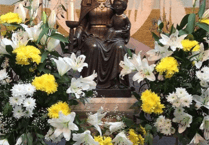Visiting troupes of entertainers used to be regular fixture throughout the summer in Aberystwyth.
Aberystwyth historian Peter Henley recalled the life of one of those entertainers.
“Ted Hopkins (1875-1927), was born in a small village called Melincryddan near Neath, south Wales,” he explained.
“Edward Lewis Hopkins was to become a talented amateur stage performer along with his sister May and brothers Richard and William.
“They became known as the Hopkins brothers’ company from 1905 mainly in Cardiff and the valleys. They headed for the stage lights of the London Coliseum where they joined the ranks of the well-known entertainer Harry Lauder with whom they also recorded their singing voices on the early wax cylinders.
“By 1910 they were appearing at Aberystwyth as ‘Ted Hopkins merry cadets’ entertaining the summer visitors in the boxy glades of Elysian Grove on a woodland stage that had been created by the Richardes family of Plas Penglais.
“He also appeared later on stage with his wife Violet at the Coliseum Theatre Aberystwyth in 1930 in a revue produced by her entitled, Ginger.
“Preceding the First World War, Ted had become a prolific theatre manager including a visit with his sister May to South Africa.

“Later, members of his troupe took on the role of summer seaside entertainers under the joint banner of ‘Hopkins and Howarth’s merry cadets’ at Weston Super Mare from 1909 -1913. Ted himself, now aged 35 appears to have stayed with his Aberystwyth merry cadets in 1910. He also opened at the popular spa town of Llandrindod Wells during those early years with his Rock Park Pierrots.
“By 1914 he was producing and conducting drama performances in the New Theatre Cardiff with the thought of setting up a Welsh drama league and the creation of a National Theatre for Wales when he appeared with the first company of Welsh artists on the London stage.
“By 1915 at the age of 40, he had stepped back from touring and had married Violet Brodrick in 1918 settling in Cowbridge Road Cardiff forming a partnership with her on stage in the city. By then they had gathered a host of well-known theatrical friends that visited their house including John Galsworthy, Will Hay, Ivor Novello and the Marquis of Bute. In 1919 the Prime Minister Lloyd George had offered Ted a Knighthood for his services to Welsh Drama. Reluctantly he turned the invitation down on the grounds that it would be detrimental to his image of the downtrodden Welshman!
“Ted had invested his savings in the Stock exchange over the years but lost heavily during the late 1920s crash. Following the cessation of hostilities in World War one, Ted and his wife decided to return to London but sadly Ted died there suddenly in 1927 at the age of 52.
The history of iconic Aberystwyth prom poster
Aberystwyth is fortunate to have an original poster in Ceredigion Museum’s collection depicting Aberystwyth bandstand and beach.
Produced by the Great Western Railway, Aberystwyth historian, Peter Henley, said: “The original artwork by Alker Tripp was created 90-plus years ago for display at numerous railway stations throughout the country to encourage visitors to travel by train to the resort. The image has been reproduced by the museum as a postcard and is now available in the tourist office and museum shop in Terrace Road, Aberystwyth.”
Sir Herbert Alker Tripp was born in Islington, London, in 1883.

Peter said: “He painted in his spare time while serving in New Scotland Yard as assistant commissioner of the London Metropolitan Police from 1932 to 1947. He was awarded the CBE in 1935 for his planned road traffic control and was knighted in 1945.
“He became a successful watercolourist and was invited to produce numerous railway travel posters for the GWR and the Southern Railway.
“Aberystwyth’s jubilee bandstand depicted in the poster was built just after the opening of the similar style nearby Art Deco Kings Hall in 1935.
“The outer perimeter wall still exists skirting today’s ultra-modern entertainment centre.
“The small original central bandstand shown in the poster had a very short existence. It was probably found to be insufferably hot inside and was replaced by an off-centre seaward side covered stage that could accommodate a larger number of performers.
“That structure was superseded in 2017 with today’s modern promenade performance venue.”

.png?width=209&height=140&crop=209:145,smart&quality=75)


